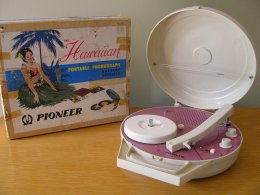Post by N_CookThe 2 yellow ones to the pickup are desoldered and loose but go to the
speaker which has 3 active terminals , 2 coils, the fourth is a dummy I
think, used as a mounting post for the electrolytic which is in the
motor circuit.
I propose the possibility that the cartridge has a double-button element
(http://www.rfcafe.com/references/electrical/NEETS%20Modules/NEETS-
Module-12-1-31-1-40.htm page 1-38); that would account for the three
wires. To go with that would be a speaker with a center-tapped voice
coil.
I imagine the circuit to be some variation of this:
wire from one side of the battery to the volume control
wire from the other side of the volume control to the cartridge common
terminal
two wires from the cartridge buttons to the ends of the speaker voice coil
wire from the speaker center-tap to the other side of the battery
Using a circuit like this would cause the DC current through the two
halves of the voice coil to produce magnetic fields that cancel each
other. However, the two audio signals would be of opposite polarity and
cause additive magnetic fields in the voice coil. This could provide
greater volume than a single-button circuit and avoid problems caused by
the DC current in the speaker moving the voice coil and cone off center.
This last bit could be compensated in the design of the speaker but it
would be complicated since changing the volume control setting changes
the DC current.
It's just a classic push-pull circuit with the out-of-phase currents
generated by a special cartridge instead of a pair of tubes or
transistors and these currents being combined in a special speaker
instead of an output transformer.
Does the circuit look like this or do I need to come up with another idea?
--
Jim Mueller ***@nospam.com
To get my real email address, replace wrongname with dadoheadman.
Then replace nospam with fastmail. Lastly, replace com with us.
